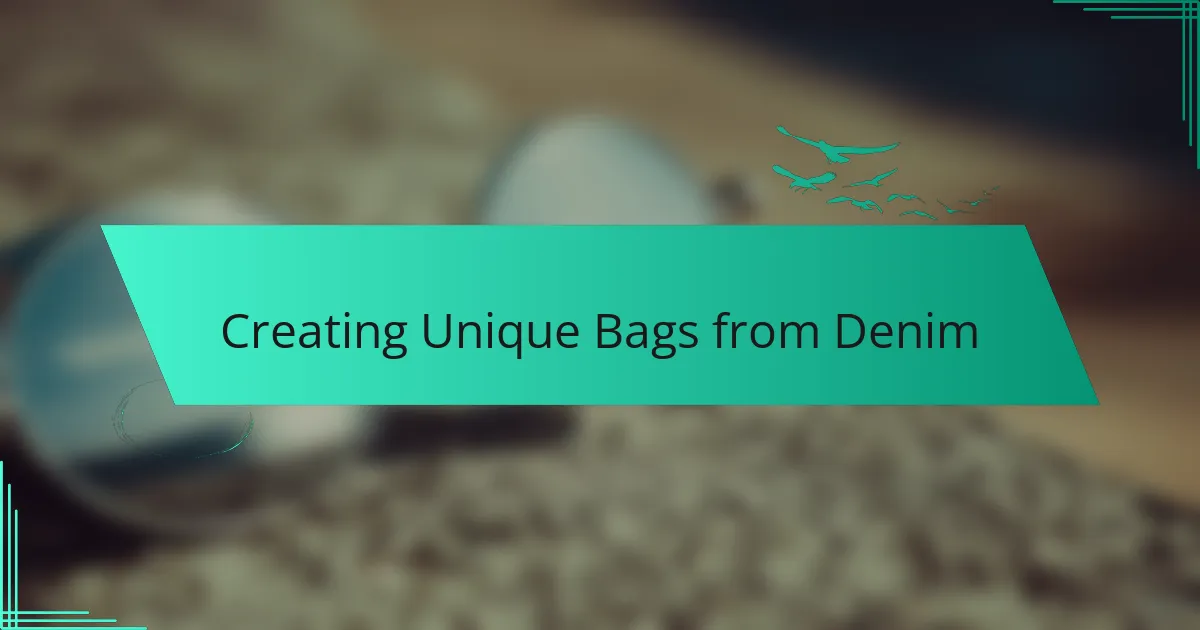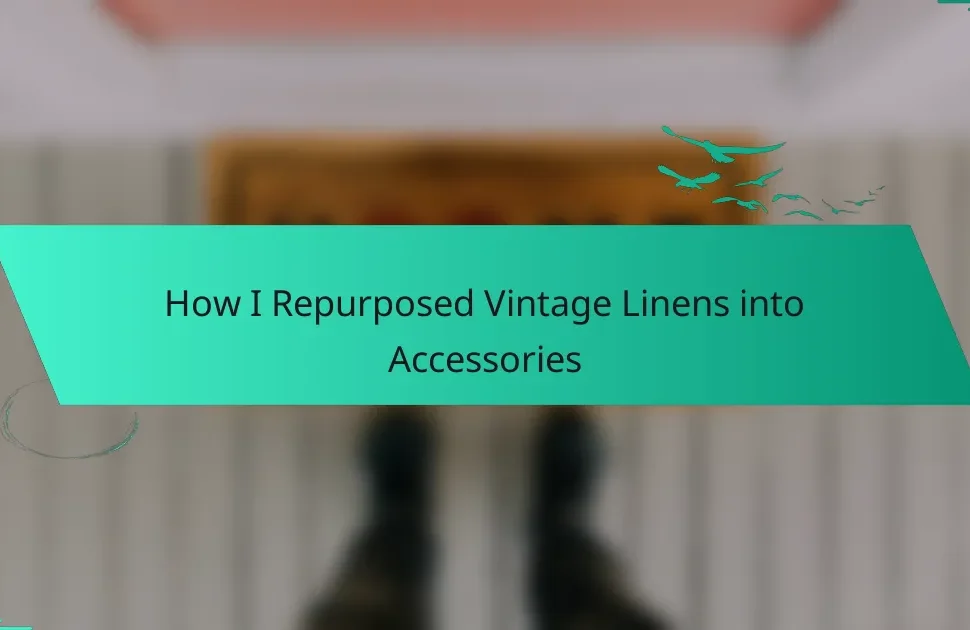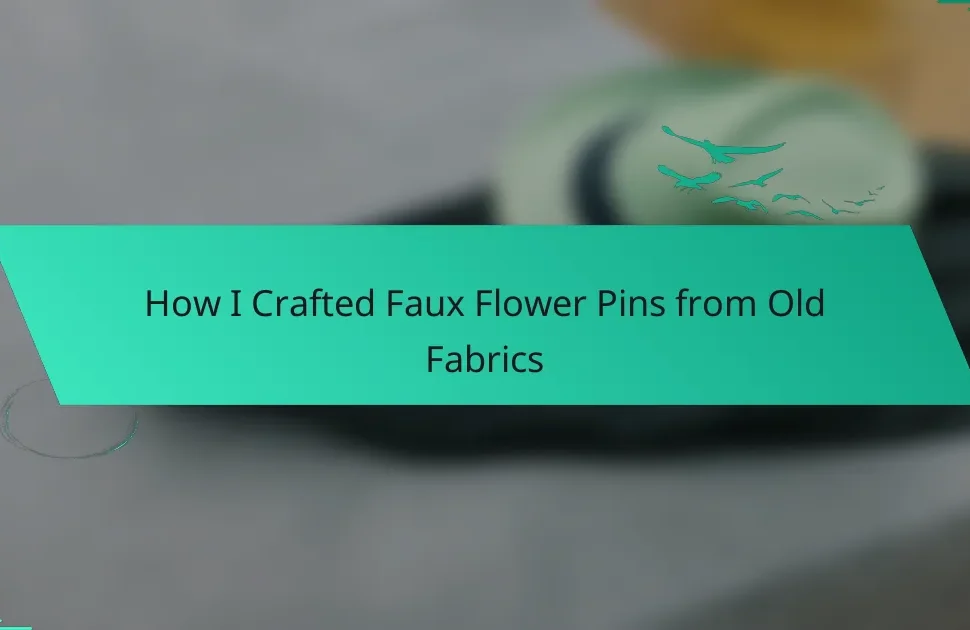Key takeaways
- Vintage denim offers a unique, personal expression and sustainability by reusing fabric.
- Distressing techniques, such as fraying and using sandpaper, can enhance the character of denim pieces.
- Personalizing denim bags with patches, embroidery, and beads transforms them into unique works of art.
- Planning ahead and embracing imperfections can lead to more creative and satisfying DIY outcomes.

Understanding Vintage Denim Fashion
Vintage denim fashion holds a special allure that transcends trends. I remember the first time I found a worn-out pair of jeans at a thrift store; they had stories etched into every fray and fading seam. When you wear vintage denim, you carry a piece of history with you, sparking curiosity in those around you.
What makes vintage denim so unique? The answer lies in the craftsmanship. Older jeans were often made with thicker, sturdier fabric, giving them a distinct quality that modern counterparts rarely match. Each rip or patch tells a tale of its past, and I find that each piece I work with in my DIY projects inspires a new vision.
Collecting and transforming vintage denim allows for a personal expression that is both artistic and nostalgic. Isn’t it magical how a simple pair of jeans can be rejuvenated into something entirely new, reflecting both your style and the fabric’s journey? Engaging in this process makes me appreciate the artistry behind these pieces even more.

Benefits of Distressing Denim
Distressing denim is not just about aesthetics; it transforms a basic piece into something uniquely personal. From my experience, each wear and tear tells its own story, making every bag one-of-a-kind. Plus, it’s a wonderful way to breathe new life into old jeans, reducing waste, and embracing sustainability in fashion.
I also find that the process of distressing can be quite therapeutic. The physical act of cutting, fraying, and shaping allows for a creative outlet that feels rewarding, especially when the end result is a stylish and functional accessory that reflects my personality.
Let’s look at some of the benefits in comparison to starting with brand-new denim:
| Benefit | Distressed Denim | New Denim |
|---|---|---|
| Uniqueness | Each piece is one-of-a-kind with its own character | Standardized look with limited personalization |
| Sustainability | Reuses old fabric, reducing waste | Contributes to new production waste |
| Cost-Effectiveness | Can save money by repurposing old clothing | Usually more expensive with added markup |
| Creativity | Allows for personal expression and creativity | Limited to the designs available in stores |

Tools for Distressing Denim
When it comes to distressing denim, the right tools can make all the difference. I’ve found that a simple pair of fabric scissors is essential. They allow for precise cuts in the fabric, which is crucial when you’re aiming for that perfectly worn look. I still remember the excitement I felt when I first saw a frayed edge on one of my bags; it was like I had unlocked a new level of creativity.
Another must-have tool in my kit is a pair of tweezers. Believe me, they are invaluable for pulling out fibers to create that soft, distressed texture. I recall a time when I painstakingly pulled threads from the hem of an old pair of jeans; the anticipation of transforming it into a bag was exhilarating. Isn’t it fun to think about how such a small tool can lead to such a significant change?
Lastly, a good sandpaper or a denim stone can.add the finishing touch. They help roughen the surface and create that authentic vintage feel. I remember the satisfaction of lightly sanding a bag I had crafted; it felt like giving the fabric a chance to share its history. How can such simple tools lead to such unique transformations? It’s a process that never ceases to amaze me.

Techniques for Distressing Denim
The process of distressing denim can be as satisfying as it is creative. One technique I often use is the classic method of fraying the edges. With a little bit of patience and a pair of fabric scissors, I carefully cut the hem of the jeans, then use my fingers to pull at the threads. Watching the fabric transform into a soft, rugged edge always feels like magic. Have you ever seen how a simple snip can change the vibe of a piece entirely?
Another approach I enjoy is using sandpaper to roughen out specific sections of the fabric. Rubbing the surface gently creates those coveted faded spots, giving the denim a well-loved appearance. I remember the first time I worked on a bag, applying the sandpaper with care. It was thrilling to see how just a few strokes could age the fabric beautifully. Doesn’t it feel rewarding to create something that looks like it has a story to tell?
Lastly, I love experimenting with bleach for a more dramatic effect. A diluted bleach solution can lighten parts of the fabric, adding contrast that highlights the natural texture. It takes a bit of courage to try, but the results can be breathtaking! I vividly recall the surprise on my face when a pair of jeans transformed from dull to eye-catching with just a splash of bleach. It’s incredible how a bit of experimentation can lead to a piece that truly stands out.

Creating Unique Bags from Denim
When I first started transforming vintage denim into bags, I was driven by a desire to create something one-of-a-kind. Each piece of denim carries its own story, from faded pockets to worn seams, which allows for a unique design that reflects my style. I find joy in the process of cutting and stitching, letting the fabric’s imperfections guide my creativity.
For anyone eager to dive into this project, here are some steps to get you started:
- Gather a variety of vintage denim pieces for texture and color.
- Decide on the bag shape; consider tote bags or crossbody styles.
- Use a seam ripper to carefully disassemble parts like pockets and belts for added flair.
- Mix and match different denim shades to create an interesting collage.
- Invest in a sturdy sewing machine to handle the thickness of the fabric.
- Personalize with embellishments like patches, beads, or embroidery for a signature touch.
Getting lost in this creative process always reminds me of how rewarding it is to see discarded items become something beautiful.

Personalizing Your Denim Bags
Personalizing denim bags is where creativity really shines. I remember the first time I added patches to a bag I made; it felt incredibly rewarding to give it a character that reflected my personality. These small additions transform an ordinary bag into a unique piece of art that tells a story.
Here are some fun ideas to personalize your denim bags:
- Patches: Sew or iron on patches that resonate with your interests—be it a favorite band, travel destination, or a meaningful quote.
- Embroidery: Add some hand-stitched designs for a personal touch; even simple stitches can create a beautiful texture.
- Fabric Paint: Use fabric paint to create your own designs or words, adding a splash of color and individuality.
- Beads and Charms: Attach beads or charms to zippers and straps for a playful and stylish element.
- Upcycled Details: Incorporate other vintage fabrics or leather scraps you have at home for a mixed-material look.
These personalized touches not only elevate your bag but also make it a reflection of who you are.

Tips for Successful DIY Projects
When embarking on a DIY project, especially with vintage denim, it’s essential to plan ahead. I’ve learned that gathering all your materials beforehand can save you from mid-project frustration. I remember starting a bag without enough thread, and the interruption turned my momentum into a battle of patience.
Another tip is to embrace imperfections. Distressing vintage denim can lead to unexpected surprises. I once cut a piece too short, and instead of starting over, I turned it into a unique fringe detail. This moment reminded me that sometimes, mistakes can lead to the most creative outcomes.
Lastly, don’t be afraid to personalize your style. Whether adding patches, beads, or fabric paint, let your personality shine through. The more you inject your creativity, the more unique your bags will become.
| Tip | Details |
|---|---|
| Plan Ahead | Gather materials before starting to maintain momentum. |
| Embrace Imperfections | Use mistakes as a chance to enhance your design. |
| Personalize | Add your own flair with patches or embellishments. |




